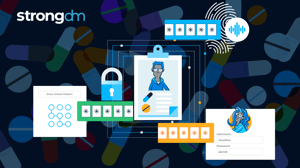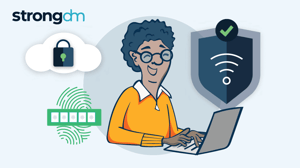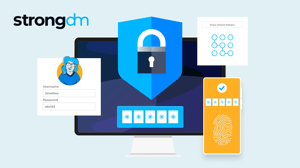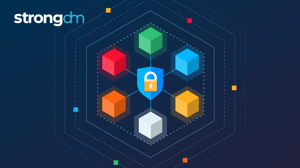
- Role-based, attribute-based, & just-in-time access to infrastructure
- Connect any person or service to any infrastructure, anywhere
- Logging like you've never seen
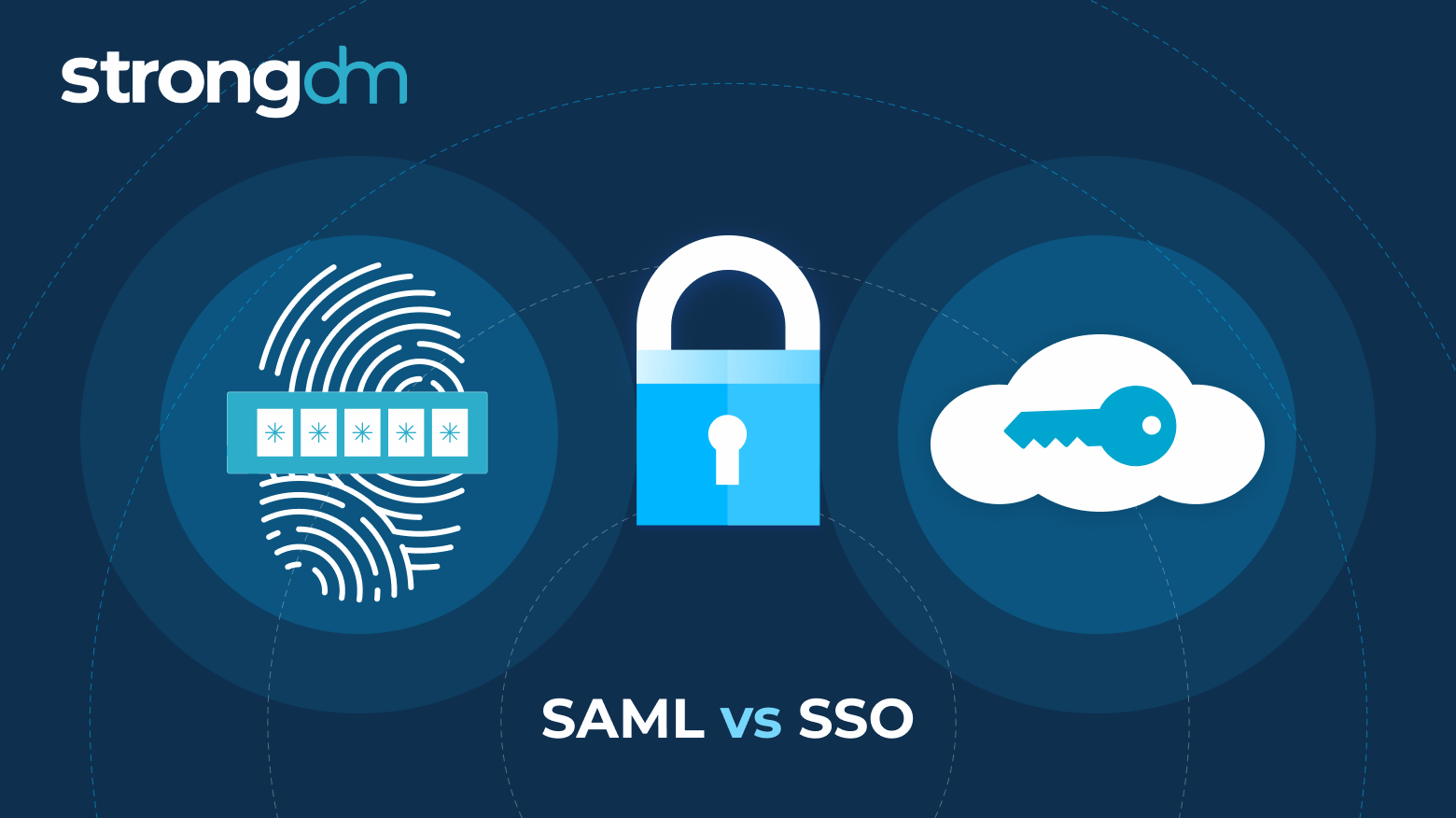
Single sign-on (SSO) gives users one login to access everything. SAML is one of the key protocols that makes that possible—passing identity data securely between identity providers and service providers. But while all SAML implementations are part of SSO, not all SSO solutions rely on SAML. Understanding how SAML fits into your authentication stack helps you choose the right tools for modern access control.
This guide breaks down how SAML works, how it powers SSO, and how you can manage authentication across every app, service, and environment with zero friction.
SAML vs. SSO: What's the Difference?
SAML enables SSO by defining how organizations can offer both authentication and authorization services as part of their infrastructure access strategy. As an open standard, SAML can be implemented by a wide variety of identity and access management (IAM) vendors. Additionally, IdPs and service providers that adhere to the standard can communicate freely, regardless of vendor.
What Is Single Sign-On (SSO)?
Single sign-on (SSO) is an authentication process that allows users to access multiple applications with a single set of login credentials, streamlining access while reducing password fatigue and enhancing security.
💡Make it easy: StrongDM centralizes authentication for every app, database, and server, delivering true SSO across your stack.
How SSO Authentication Works
SSO starts when a user tries to access a protected app and is redirected to an identity provider (IdP) for authentication. After verifying the user's credentials, the IdP issues an access token, granting access to multiple apps without repeated logins—like signing into Google and getting into Gmail, YouTube, and Drive.
Modern SSO uses protocols like OpenID Connect and SAML to standardize communication between apps and IdPs, relying on secure token exchanges and session management to maintain safe access across systems.
Benefits of Single Sign-On Solutions
Modern enterprises struggle to manage secure access across many apps. SSO helps by reducing password fatigue and improving security.
Users can access apps without repeated logins, boosting productivity and ease of use. IT teams benefit from centralized control, making it easier to manage user access and permissions.
SSO also enhances security by limiting password reuse and encouraging stronger credentials. Paired with multi-factor authentication, it offers strong protection with a smooth user experience.
What Does SAML Stand For?
Security Assertion Markup Language (SAML) is an open standard protocol used to exchange authentication and authorization data between identity providers and service providers, enabling secure single sign-on across web applications.
💡Make it easy: StrongDM natively supports SAML, allowing secure, scalable SSO across your web applications and infrastructure.
SAML Protocol Explained
SAML is an open standard that enables secure authentication between identity providers and service providers using XML-based assertions.
When a user tries to access a resource, SAML passes signed tokens with identity and access details from the IdP to the service provider, verifying the user's rights.
Its use of standardized formats and digital signatures makes SAML ideal for enterprise SSO, enabling secure access across multiple apps and domains.
Core Components of SAML 2.0
SAML 2.0 relies on three core elements: assertions (user identity and access rights), protocols (rules for exchanging authentication data), and bindings (how messages travel over HTTP or SOAP).
Together, they form SAML profiles—standardized setups for use cases like web browser SSO. This structure enables secure, seamless access across apps and domains while ensuring consistent identity verification in enterprise environments.
The Relationship Between SAML and SSO
How Does SSO Work with SAML?
When a user attempts to access a protected app, SAML and SSO work together in a choreographed sequence. The service provider redirects the user to their organization's identity provider, where SAML creates an encrypted assertion containing the user's authentication status and permissions.
This assertion acts like a digital ID card, allowing employees to move seamlessly between different applications. The identity provider signs these assertions with a unique certificate, ensuring secure transmission of credentials across multiple domains and applications.
For companies implementing this solution, SAML handles the complex authentication process while SSO provides the user-friendly interface. This partnership enables third parties to verify user identities without storing sensitive credentials, creating a secure and efficient authentication framework.
💡Make it easy: StrongDM simplifies SAML-backed SSO deployments so your users enjoy secure, frictionless access to all systems.
Identity Provider (IdP) and Service Provider (SP) Roles
In the SAML framework, identity providers serve as trusted authentication sources that verify and maintain user credentials. They manage user identities, handle login processes, and generate secure assertions about user authentication status.
Service providers focus on delivering applications and resources to authenticated users. These entities rely on IdPs to confirm user identities rather than managing credentials directly, creating a clear separation of responsibilities that enhances security.
This division of roles enables organizations to centralize authentication while maintaining independent service delivery. When users need access to multiple applications, the IdP handles verification once, while different SPs can trust these authentication decisions without implementing their own identity management systems.
SAML Authentication Flow
SP-Initiated vs IdP-Initiated SAML
SAML supports two distinct authentication flows that determine how users begin their login journey. With SP-initiated SAML, users start at the service provider's application, triggering a redirect to the identity provider for authentication. This common approach provides stronger security through request validation and protection against man-in-the-middle attacks.
IdP-initiated SAML begins at the identity provider's portal, where users select their desired application from a dashboard. The IdP then generates an assertion and sends the user directly to the service provider. While this streamlines access for users working primarily from enterprise portals, it offers fewer security guarantees since the SP receives no initial authentication request to validate against the response.
Organizations often implement both flows based on specific use cases. SP-initiated serves direct application access needs, while IdP-initiated suits enterprise environments where users regularly launch multiple services from a central portal.
SAML Token and Assertions Explained
SAML tokens serve as secure digital passports in the authentication process. These XML-formatted documents contain assertions - signed statements about a user's identity, attributes, and access rights. The assertions come in three distinct types: authentication assertions prove user identity, attribute assertions carry specific user information, and authorization assertions define what resources the user can access.
The SAML token's power lies in its cryptographic security. Each assertion is digitally signed by the identity provider using public key infrastructure, ensuring that service providers can verify the token's authenticity. This signature, combined with time stamps and audience restrictions, prevents token theft and replay attacks.
During the authentication flow, these assertions travel securely between systems through SAML bindings, maintaining confidentiality through encryption while allowing service providers to make informed access decisions based on trusted identity information.
Alternative Authentication Protocols
OAuth and OpenID Connect (OIDC)
OAuth 2.0 and OpenID Connect work together to provide modern authentication and authorization solutions. While OAuth handles authorization by allowing applications to access resources on behalf of users, OpenID Connect adds a standardized authentication layer to verify user identities.
These protocols excel in different scenarios than SAML. OAuth's token-based approach makes it ideal for mobile applications and APIs, where traditional browser-based flows might not be practical. OpenID Connect extends this functionality by providing user profile information through standardized endpoints, making it perfect for social login implementations and mobile apps.
The combination of these protocols creates a flexible framework for access management. Developers can implement OAuth for API authorization while using OpenID Connect's ID tokens to maintain consistent user sessions across multiple applications, providing a seamless experience without compromising security.
💡Make it easy: StrongDM supports OAuth, OIDC, and SAML—giving you flexibility to manage access across web, mobile, and API-based apps.
Kerberos and Other Authentication Methods
Kerberos serves as a network authentication protocol that uses ticket-based validation to secure communications between trusted hosts. Through its Key Distribution Center (KDC), Kerberos provides mutual authentication where both the user and the service verify their identity to each other.
Unlike web-focused protocols such as SAML, Kerberos excels in enterprise environments where all systems exist within the same network domain. When users log into their domain-joined machines, Kerberos validates their credentials and issues time-stamped tickets for accessing network resources without requiring repeated logins.
Many organizations combine multiple authentication methods to meet diverse needs. While Kerberos handles internal network authentication, they may employ SAML for web applications and LDAP for directory services, creating a comprehensive access management strategy that balances security with user convenience.
💡Make it easy: StrongDM integrates with Kerberos and other authentication methods, centralizing access without disrupting existing systems.
Implementing SAML-Based SSO
Integration with Identity Providers
Successful SAML integration requires careful planning between your organization and chosen identity providers. Modern enterprises typically begin by mapping their authentication workflows and determining which user attributes need to be exchanged. The SAML service provider creates metadata containing certificate and endpoint information, which the identity provider uses to establish trust.
Organizations can streamline implementation by leveraging SAML-ready identity providers that offer pre-built configurations. These solutions handle complex XML formatting, certificate management, and user synchronization behind the scenes, reducing integration time from months to days. For enterprise deployments, teams must consider factors like user provisioning rules, session duration settings, and multi-factor authentication requirements.
Best Practices for Implementation
Securing SAML-based SSO requires robust controls at both the protocol and operational levels. Start by enforcing strong encryption standards for all SAML assertions and implementing strict certificate validation checks. Use unique, randomly generated identifiers for each session to prevent replay attacks.
Configure appropriate session timeout values and implement automatic user provisioning and de-provisioning workflows. Monitor authentication attempts and maintain detailed audit logs of all SSO activities. For enhanced security, pair your SAML implementation with multi-factor authentication.
Regular security assessments help identify potential vulnerabilities in your SAML configuration. Keep XML libraries updated, validate all SAML responses before processing, and maintain secure key storage practices. Remember to properly sanitize all input data to prevent injection attacks and cross-site scripting vulnerabilities.
When to Use SAML vs Other Protocols
Enterprise Use Cases
Financial institutions and healthcare organizations widely adopt SAML-based SSO to meet strict compliance requirements while managing access across multiple systems. For example, when medical staff need seamless access to patient records, billing systems, and pharmacy databases, SAML provides secure authentication without compromising workflow efficiency.
Manufacturing enterprises leverage SAML's federation capabilities to grant controlled access to suppliers and contractors. A production manager can authenticate once through their corporate identity provider and securely access both internal inventory systems and external partner portals, maintaining security without hindering collaboration.
Government agencies implement SAML to establish trusted authentication channels between departments. This enables public servants to access cross-agency resources while maintaining proper security boundaries and audit trails.
💡Make it easy: StrongDM powers secure SAML-based access to critical systems, helping enterprises meet compliance without friction.
Web Application Requirements
Modern web apps, especially single-page and mobile-first designs, often prefer lightweight JSON-based protocols like OIDC over XML-heavy SAML.
SAML is strong for server-side apps needing detailed security assertions, while OIDC suits apps with real-time API access and mobile support. Protocol choice depends on factors like architecture, data sensitivity, and user experience.
SAML works well with traditional web flows but may need adjustments for microservices or APIs. The best fit depends on aligning protocol strengths with your app’s design and security needs.
💡Make it easy: StrongDM lets you mix and match protocols like SAML and OIDC without losing centralized control or visibility.
StrongDM’s Approach to SAML and SSO: Simplified, Secure, and Centralized
SAML isn’t just another acronym—it’s the backbone of secure, scalable SSO for modern enterprises. But implementing it across complex environments? That’s where most solutions fall short. StrongDM makes SAML-backed SSO work across every app, service, and infrastructure layer—without the headaches.
Here’s how StrongDM helps you master SAML and SSO without compromise:
- SAML-Based SSO Across Your Stack: Use SAML to authenticate once, then access everything—from web apps to databases and Kubernetes clusters. StrongDM supports SAML out of the box with any IdP (Okta, Azure AD, Google Workspace, etc.), so you don’t need to worry about vendor lock-in or manual configurations.
- Frictionless Access for Users: No more juggling logins. StrongDM delivers seamless SSO experiences via secure token exchanges and policy-driven access. Whether it’s SP-initiated or IdP-initiated flows, users enjoy one-click access that doesn’t compromise security.
- Protocol Flexibility: SAML, OIDC, OAuth, Kerberos—It’s All Here: Not every system speaks the same language. StrongDM bridges that gap, letting you use the right protocol for the right app—while maintaining centralized access governance. Mix SAML for your legacy enterprise apps, OIDC for your web front ends, and Kerberos for your internal systems—all in one place.
- Enterprise-Grade Security Built In: StrongDM enforces MFA, session timeouts, encryption, and certificate management across all your authentication protocols—ensuring your SAML implementation is resilient, compliant, and always audit-ready.
- Real-Time Monitoring & Audit Trails: Every login, token issuance, and access request is logged and visible in real-time. StrongDM gives security and compliance teams the visibility they need to meet standards like SOX, HIPAA, and ISO 27001—with less manual work.
Use Case Spotlight:
- Healthcare provider: SAML-based SSO gives doctors access to EHRs, prescription tools, and billing systems—all via one secure login.
- SaaS enterprise: Combine OIDC for your front-end, SAML for admin tools, and Kerberos for internal dev access—managed in a single control plane.
- Government agency: Federation across departments without losing visibility or control.
Forget the XML wrangling, token misfires, or protocol mismatches. StrongDM turns authentication into a unified, low-friction experience—no matter your protocol, infrastructure, or identity provider.
Book a demo and see how StrongDM can make your SAML-based SSO strategy bulletproof.
About the Author
John Martinez, Technical Evangelist, has had a long 30+ year career in systems engineering and architecture, but has spent the last 13+ years working on the Cloud, and specifically, Cloud Security. He's currently the Technical Evangelist at StrongDM, taking the message of Zero Trust Privileged Access Management (PAM) to the world. As a practitioner, he architected and created cloud automation, DevOps, and security and compliance solutions at Netflix and Adobe. He worked closely with customers at Evident.io, where he was telling the world about how cloud security should be done at conferences, meetups and customer sessions. Before coming to StrongDM, he lead an innovations and solutions team at Palo Alto Networks, working across many of the company's security products.

You May Also Like
